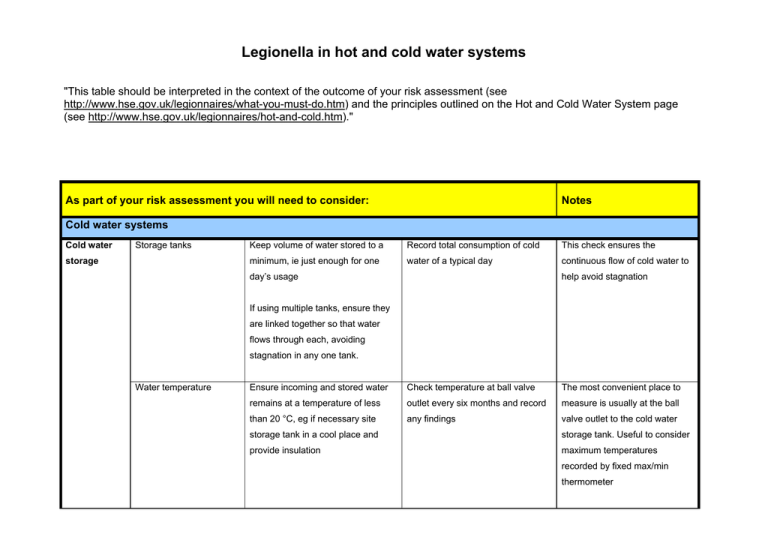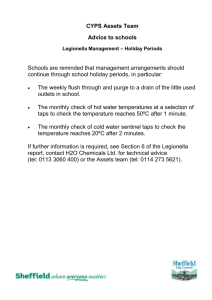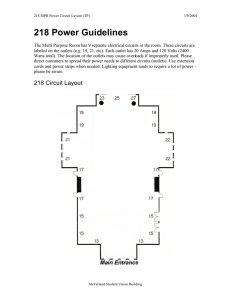Hot and cold water table - Legionella
advertisement

Legionella in hot and cold water systems "This table should be interpreted in the context of the outcome of your risk assessment (see http://www.hse.gov.uk/legionnaires/what-you-must-do.htm) and the principles outlined on the Hot and Cold Water System page (see http://www.hse.gov.uk/legionnaires/hot-and-cold.htm)." As part of your risk assessment you will need to consider: Notes Cold water systems Cold water Storage tanks storage Keep volume of water stored to a Record total consumption of cold This check ensures the minimum, ie just enough for one water of a typical day continuous flow of cold water to day’s usage help avoid stagnation If using multiple tanks, ensure they are linked together so that water flows through each, avoiding stagnation in any one tank. Water temperature Ensure incoming and stored water Check temperature at ball valve The most convenient place to remains at a temperature of less outlet every six months and record measure is usually at the ball than 20 °C, eg if necessary site any findings valve outlet to the cold water storage tank in a cool place and storage tank. Useful to consider provide insulation maximum temperatures recorded by fixed max/min thermometer Legionella in hot and cold water systems Avoid external Fit tank with tight fitting lid and air Check to ensure tank remains Visually inspect cold water contamination and build vent clean, at least annually storage tanks and carry out up of sludge, scale and Cold water remedial work where necessary rust Maintain tank in a clean condition Water temperature Check water temperature at sentinel After running for two minutes at This action helps to ensure that outlets on monthly basis sentinel taps, the temperature the supply and flow of cold water should be below 20 °C. Record remains at a temperature that findings will not encourage the growth of outlet, eg taps and Check representative outlets for showerheads temperature as above on a rotational basis legionella Check annually Selection of representative outlets should be assessmentdriven to ensure the entire system is covered over a period of time Hot water systems Hot water Hot water cylinder/ Visual check, where possible on Check to ensure tank remains Useful to sample water from hot systems calorifier internal surfaces of cylinders for clean, at least annually water cylinders to note condition scale and sludge Avoid contamination and build up of sludge, scale of drain water and assess cleanliness of tank Legionella in hot and cold water systems Water temperature Check flow and return temperatures Monthly checks should be carried Hot water should be stored at at calorifiers. Outgoing water should out and findings recorded 60 °C at least in order to kill be at least 60 °C legionella bacteria. The thermometer pocket at the top of Check water temperature at sentinel the cylinder and on the return outlets on a monthly basis leg, if fitted, is a useful point for The water temperature should be at accurate temperature Check representative outlets for ° least 50 C within one minute of measurement. If installed, these temperature as above on a running the water measurements could be carried rotational basis out by a building management system If thermostatic mixer valves (TMV’s) are fitted, measure temperature at This check makes sure that the the hot water inlet to the TMVs supply and return temperatures The water supply to the TMV ° on each hot water loop are should be at least 50 C within one unchanged, ie the loop is minute of running the water functioning as required Selection of representative outlets should be assessmentdriven to ensure the entire system is covered over a period of time Legionella in hot and cold water systems Selection of representative outlets should be assessmentdriven to ensure entire system is covered over a period of time One way of measuring this is to use a surface temperature probe Hot water Avoid long pipe runs between TMV pipe work and outlet Pipe runs should not exceed 2 m ‘At risk’ Assessment should be Sampling for legionella from water Samples should be taken from Periodically (as identified population carried out to determine if system should be carried out appropriate outlets and storage through risk assessment) residents are immuno- tanks/cylinders. These should be compromised and analysed by a competent company consequently classified into the “at risk” group For all hot and cold water systems Pipework Avoid stagnation, Remove dead ends/blind ends from For infrequently used outlets, Flush through and purge to unnecessarily long the system and ensure regular instigate a programme of regular drain, without release of pipework runs, and flushing of dead legs flushing, ie weekly aerosols Legionella in hot and cold water systems transfer of heat from other sources Keep pipe runs as short as possible Insulate water pipes in work areas where heat may be transferred from other sources, ie hot water pipes Showerheads Avoid build up Dismantle, clean and descale Should be carried out quarterly contamination on showerheads or as determined by risk showerheads assessment






